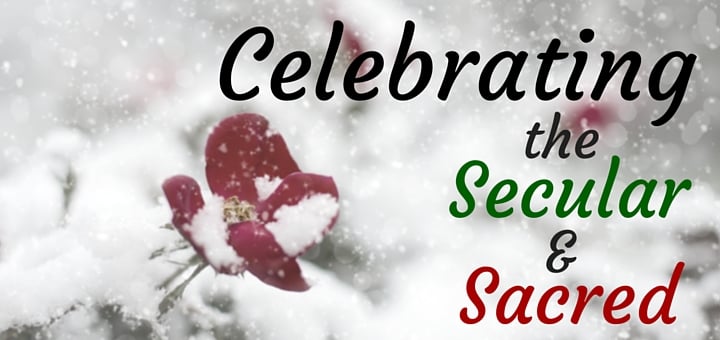My husband, Ben, and I attended the festive Holiday Pops performance put on by the Fort Wayne Philharmonic, a beloved and well-anticipated Christmas tradition for us. For years we have attended this lively and dramatic conglomeration of dancing, singing, and orchestral music. I've often mused at the variety of both secular and sacred music, though the sacred was not as prominent as some of the secular Christmas classics, like, "Baby, It's Cold Outside" or "It's the Most Wonderful Time of the Year." It never bothered me, but I made note of the people in our lives who seemed chagrined at the dearth of truly holy Christmas music and messages.
It's no surprise to any of us that Christmas is more secularized with each passing year. Even once sacrosanct customs, such as decorating a Christmas tree or hanging a wreath of greenery with red berries has become both cliched and worldly. Yet I had to wonder this year as Ben and I exited the front row of the Embassy, the why of it all.
Why are there countless songs of the holiday season about love, reconciliation, reunions, peace, charity? Why do we watch movies, like "It's a Wonderful Life" or "Elf," which have no overt Christian message? What about the beloved icon of Santa Claus, the jolly and benevolent soul who delivers gifts to all? While it's true that these, and other, Christmas customs are devoid of substantive meaning and often eliminate (or at the very least lessen) the holiness of the Incarnation, I think it's worth looking a bit more deeply at all of the Christmas images, movies, and songs we encounter this year.
Because the Holiday Pops program included incredibly beautiful and traditional selections of Christmas hymns that were played with intention and intensity, I realized one very simple but profound point: Everything about Christmas points back to Jesus.
So maybe Santa Claus and Rudolph don't have anything to do with Jesus on the exterior, but look deeper. Santa Claus is based on St. Nicholas, a real and miraculous saint who lived during the fourth century in what is now known as Turkey. Rudolph is a tale of an ostracized reindeer who hates being different and yet, in the end, is accepted and even lauded for using his unique gift in a way no other reindeer could.
Maybe some of these messages are corny, but I have to believe that they were inspired by the true meaning of Christmas. One cannot ponder, even for a fleeting instant, the profundity of the Incarnation without being inspired in some way. It takes a child - the Christ-child - to remind all of us that what matters most in life is love, finding time to repair and patch our strained relationships, seeking peace and working for justice, accepting others for who they are interiorly, and creating Christian unity. While this is a limited explanation of the beauty of this sacred season, it is a partial perspective that may warrant further reflection.
So every time you walk into the world, perhaps doing your weekly grocery shopping, and hear a song that isn't necessarily about Jesus, pause for a moment and remember the hidden message that, like the infant Savior, is waiting for us to find. Jesus was wrapped in swaddling clothes, concealed in a tiny manger in Bethlehem. And, just as He hides Himself in the form of a small Host, He does so, because He longs for us to seek Him - just as the Magi did over two thousand years ago.
Seek Him, dear friend, in everything around you this Advent and Christmas. Do not neglect to find Him in the most unusual or perhaps odd places. He is there, I assure you, ready and eager to embrace you in the innermost crevices of your heart. Open, then, your heart to Jesus this Advent so that He may be born in you, whether you are celebrating the sacred or the secular.
Copyright 2015 Jeannie Ewing, all rights reserved.
Image copyright 2015 "Red Rose" by jill111 on Pixabay and edited in Canva by Jeannie Ewing.
About the Author
Jeannie Ewing
Jeannie Ewing believes the world ignores and rejects the value of the Cross. She writes about the hidden value of suffering and even discovering joy in the midst of grief. As a disability advocate, Jeannie shares her heart as a mom of two girls with special needs in Navigating Deep Waters and is the author of From Grief to Grace , A Sea Without A Shore , and Waiting with Purpose. Jeannie is a frequent guest on Catholic radio and contributes to several online and print Catholic magazines. She, her husband, and three daughters live in northern Indiana. For more information, please visit her website lovealonecreates.com.



.png?width=1806&height=731&name=CatholicMom_hcfm_logo1_pos_871c_2728c%20(002).png)
Comments